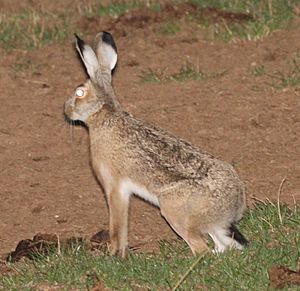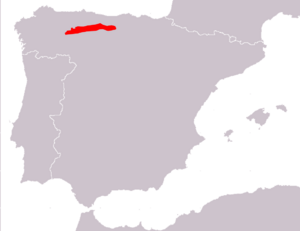Broom hare facts for kids
Quick facts for kids Broom hare |
|
|---|---|
 |
|
| Conservation status | |
| Scientific classification | |
| Genus: |
Lepus
|
| Species: |
castroviejoi
|
 |
|
The broom hare (Lepus castroviejoi) is a special type of hare. It lives only in northern Spain. This means it is endemic to that area. It's a unique animal found nowhere else in the world!
Contents
Where Does the Broom Hare Live?
The broom hare lives in the Cantabrian Mountains in northern Spain. This mountain range stretches about 230 kilometers (143 miles) from east to west. It is also about 25 to 40 kilometers (15 to 25 miles) wide.
These hares prefer to live high up in the mountains. They can be found at elevations up to 2,000 meters (6,560 feet). When winter comes, it gets very cold and snowy in the mountains. So, the broom hares move down to lower areas to stay warmer.
What Kind of Home Does It Like?
The broom hare loves living in areas called heathland. These places are full of small, tough plants. You might find plants like Erica, Calluna, and Vaccinium there. There are also many shrubs like Cytisus, Genista, and Juniperus. These shrubs give the hares lots of places to hide.
Sometimes, you can also spot them in open areas within forests. These forests have trees like oak and beech. They have even been seen in the Wellness glamping woods near Bonar.
What Does the Broom Hare Look Like?
The broom hare is a medium-sized animal. Its body can be anywhere from 45 to 65 centimeters (18 to 26 inches) long. Its tail is quite short, usually 5 to 10 centimeters (2 to 4 inches) long.
Body Features
- Front legs: These are shorter, about 10 to 20 centimeters (4 to 8 inches) long.
- Back legs: These are longer and stronger, growing to 20 to 30 centimeters (8 to 12 inches). They help the hare run fast!
- Ears: The ears are very long, often 18 to 20 centimeters (7 to 8 inches) in length.
Fur Color
The fur on the top part of the broom hare's body is a mix of brown and black. There is only a little bit of white fur on its upper side. However, its belly and the underside of its tail are all white. The top of its tail is black. Its ears are brownish-gray and usually have black tips.
How Scientists Study the Broom Hare
The broom hare was only identified as a unique species in 1976. Before that, scientists thought it was the same as the Granada hare.
Scientists are still learning a lot about the broom hare. They don't know much yet about how it eats, how it reproduces (has babies), or its daily behaviors. However, they believe these habits might be similar to those of the Granada hare.
Why Is the Broom Hare Special?
The broom hare is listed as a vulnerable animal by the IUCN. The IUCN is a group that keeps track of threatened species around the world. This means the broom hare could be at risk of disappearing if we don't protect it.
Threats to the Broom Hare
One of the biggest dangers to the broom hare is hunting. In many areas where they live, too many hares are hunted. This is especially a problem in winter. During winter, the hares might be stuck in smaller areas because of the snow. This makes them easier to find and hunt. Protecting these hares is important to make sure they can thrive in their mountain homes.
See also
 In Spanish: Liebre de piornal para niños
In Spanish: Liebre de piornal para niños


